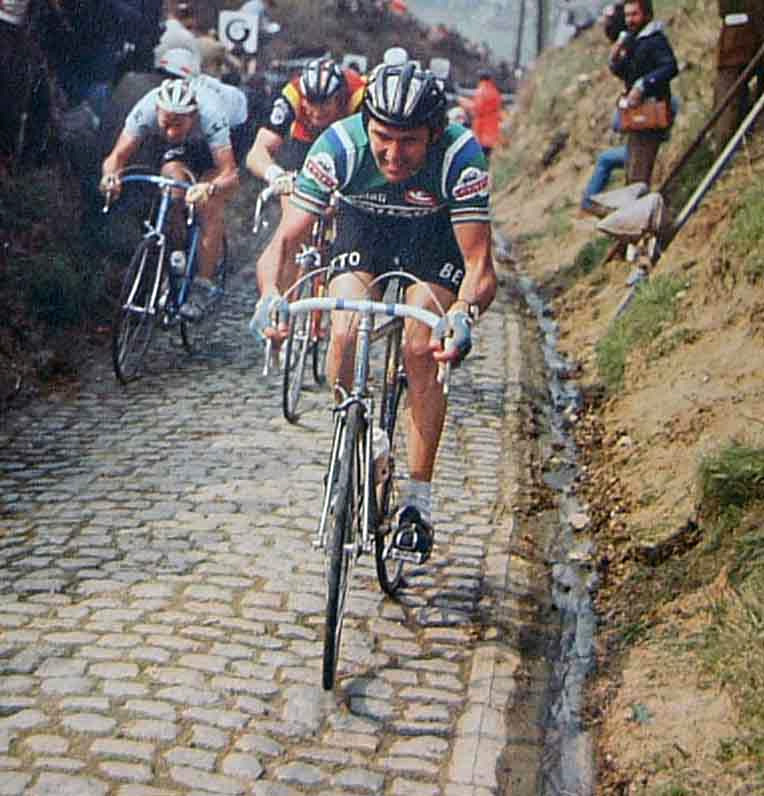Photo from Wikipedia, Creative Commons License, due to Mick Knapton.
Compared to LBL, FW and PR, de Ronde is a newbie, started in 1913 by a co-founder of, guess what, a sports newspaper Sportwereld. By this time in history, Belgian races such as the LBL and FW were already quite established. And coincidentally, they were all run by French-speaking organizers in the French-speaking part of Belgium. Not surprisingly, sportsmen from the Flemish-speaking region of Belgium felt slightly left out by the lack of any races to celebrate their region.
This disappointment bubbled over with the victory of Odile Defraye, a son of the Flanders region, in the 1912 Tour de France. In fact, his was the first win by a Belgian. The newspaper Sportwereld was founded to leverage the growing interest of Flemish speakers and naturally this newspaper wanted its own race.
Now it is important for us to start to distinguish between Flanders the region and Flanders of the two provinces of Belgium, namely West Flanders and East Flanders. De Ronde van Vlaanderen RVV refers to the Tour of the Two Provinces Called Flanders, not of the greater region of Flanders. Just as it does today, the route of the RVV goes around towns in the western part of the region of Flanders where the two provinces are located.
In fact, the culture of the two parts of the region of Flanders are so distinct that most Flemish-language television programs are sub-titled because people from the western part of the region cannot easily understand people from the eastern part of the region, and vice-versa!
The location of the RVV proved to be a blessing: where the eastern part of the Flemish region is nearly pancake-flat, the western part where the race is held is full of short but sharp hills. Over time, these hills - called hellingen - came to characterize the race itself.
The success of the RVV beget the founding of other races in the region. Gent-Wevelgem was started in 1934, taking a more westerly route from Gent towards Wevelgem. Dwars door Vlaanderen, which translates to rambling across Flanders, started in 1945. The race that is today known as de Omloop Het Nieuwsblad started in 1945 as Gent-Gent, then de Omloop Het Volk when the organization was bought by the newspaper Het Volk, and it changed name again when that newspaper got bought by a more profitable one Het Nieuwsblad.
E3 Harelbeke is named after the route that it follows to the finish like in Harelbeke, and was started in 1958. Finally the Brabantse Pijl, or Flèche Brabançonne in French, was sort of the twin of Flèche Wallonne, both darting mostly west-east. It was first run in 1975.
Now it is worth noting that organizers in the Antwerp region had started Scheldeprijs in 1907, long before de Ronde was conceived. But why didn't it become the prominent race of the Flemish region? The answer is perhaps in the curse of geography: the flatter eastern region around Antwerp is pancake-flat, with lots of silt and sand deposits. Simply put, it was hard for it to develop a unique and challenging character.
What of the other races?
The Omloop, which starts very early in the season, features many of the climbs of the Ronde. It traditionally heads south from the Gent area, tackles many of the hellingen, and heads back north to the Gent area. Thus, it is seen as an excellent test of form for those who dream of glory in de Ronde. However, as it ends in the Gent area, its finale typically features more flat sections of cobbles than hills. Thus, it is not often that the same rider wins both de Omloop and de Ronde.
Gent-Wevelgem over time became known more as a sprinters' classic as it is on flatter terrain, missing most of the hellingen that reside south of Gent. Dwars door Vlaanderen traditionally finishes in Waregem, but covers some of the same climbs as the Ronde.
E3 is fortunately run over many of the same hellingen as de Ronde, and in recent year has been an excellent predictor of performance in de Ronde, even if its finishing town is nowhere near the finishing town of de Ronde. If anything else, it is worth noting that it usually runs mere days from de Ronde.
Brabantse Pijl traditionally finishes near that tiny sliver of Flemish region south of Brussels, and features a few laps that includes climbs toward the finish. But these climbs are never used in de Ronde. By nature of it finishing in a circuit, it takes on its own unique personality.
Ironically, the first run of de Ronde in 1913 failed to attract Defraye, who decided to trek down to Italy instead where he won the then-more established Milano-Sanremo ..
So there you have it, a discourse on the classics races and how they relate to each other. I hope that it helps you understand how they relate to each other a little better.
Until next time, when we shall discuss Milano-Sanremo, la Primavera!

No comments:
Post a Comment